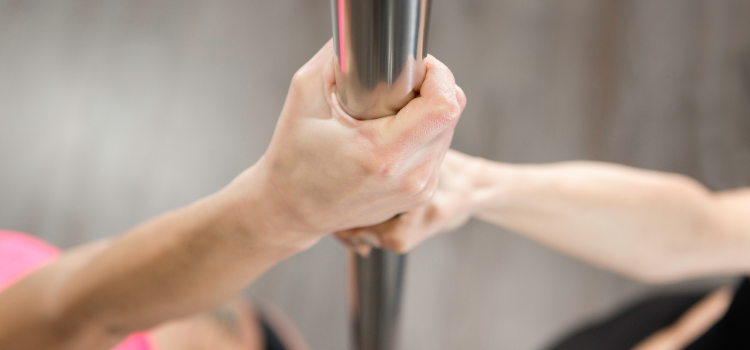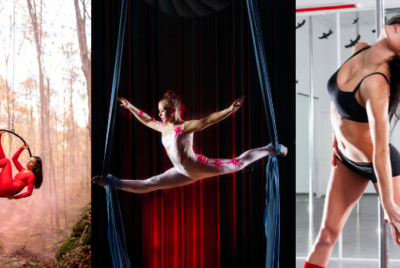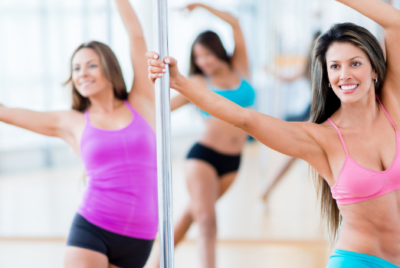Pole Grip Essentials: Maximising Your Pole Dancing Experience
Introduction
Pole dancing is a captivating form of self-expression that demands strength, grace, and technique. As a pole dancing enthusiast, you know that grip plays a vital role in executing moves with confidence and control. In this article, we will delve into the key factors that can enhance your pole grip, covering the benefits of clothing, pole shoes, and grip aids. By understanding how each element contributes to your grip, you can take your pole dancing to new heights.
Importance of Pole Grip Technique
Proper pole grip technique plays a crucial role in pole dancing for several reasons. It provides stability, control, and confidence, enabling you to perform a wide range of moves with ease and grace. A strong grip also minimises the risk of slipping or accidents, ensuring a safer and more enjoyable experience.
Factors Affecting Pole Grip Technique
Several factors can influence your pole grip technique. Understanding these factors will help you address any weaknesses and improve your overall grip strength and control.
Hand Placement and Pressure: Proper hand placement and distributing pressure evenly are essential for a strong grip. Ensure your hands are correctly positioned on the pole, aligning with its contours. Avoid excessive gripping or squeezing, as it can lead to fatigue and reduced grip control.
Skin Condition and Moisture: The condition of your skin and its moisture levels can impact your grip. Dry or rough skin may lack the necessary friction, while excessively sweaty or oily skin can make it harder to maintain a secure hold. Keep your skin well-hydrated and moisturised, striking a balance that promotes optimal grip.
Pole Material and Finish: The type of pole and its surface finish can affect your grip. Different materials, such as chrome, stainless steel, or brass, offer varying levels of grip. Additionally, the finish of the pole, whether smooth or textured, can influence the friction between your skin and the pole surface.
Tips for Improving Pole Grip Technique
Now that we understand the importance of pole grip technique and the factors affecting it, let’s explore some practical tips to enhance your grip on the pole.
Proper Warm-up and Stretching: Before each pole dancing session, it’s crucial to warm up your body and specifically your hands. Perform gentle stretching exercises that focus on your wrists, fingers, and forearms. Warming up increases blood flow, loosens up your muscles, and prepares your hands for optimal grip.
Grip Strength Training: Incorporating grip strength training exercises into your regular workout routine can greatly enhance your pole grip technique. Exercises such as finger curls, forearm squeezes, and towel hangs can help strengthen the muscles in your hands, fingers, and forearms, improving your overall grip strength.
Focus on Body Alignment: Proper body alignment is key to maintaining a strong grip on the pole. Ensure your shoulders are engaged and aligned with your wrists while keeping your core muscles activated. Maintain an upright posture and avoid leaning or twisting excessively, as it can compromise your grip and stability.
Experiment with Grip Aids: Grip aids can provide additional support and enhance your pole grip technique. Try different grip aids such as grip powders, grip sprays, or grip lotions to find the ones that work best for your skin type and the pole surface. However, use grip aids sparingly to avoid dependency and allow your natural grip strength to develop.
Common Mistakes to Avoid
While focusing on improving your pole grip technique, it’s important to be aware of common mistakes that can hinder your progress.
Neglecting Hand Conditioning: Neglecting hand conditioning exercises can limit your progress in developing a strong grip. Make hand conditioning a regular part of your training routine to build the necessary strength and endurance in your hands and fingers.
Poor Hand Engagement: Failing to fully engage your hands on the pole can lead to a weak grip. Ensure your hands are firmly wrapped around the pole, maintaining contact with both the palm and the fingers. Avoid cupping or lifting your fingers away from the pole, as it can compromise your grip.
The Basic Pole Grips: Step-by-Step Instructions
Let’s explore some of the essential basic pole grips along with detailed instructions on how to perform them correctly:
Basic Hand Grip:
1: Stand next to the pole with arms extended overhead.
2: Grab the pole with your dominant hand, palm on the pole, fingers wrapping around it.
3: Engage fingers for a firm grip without excessive squeezing.
4: Place non-dominant hand slightly below the dominant hand, creating a stacked hand position.
5: Keep shoulders engaged and aligned with wrists.
6: Maintain a slight bend in elbows for control and flexibility.
Tip: Relax shoulders, maintain straight posture, and avoid gripping too tightly to prevent fatigue.
Cup Grip:
1: Stand facing the pole with arms extended overhead.
2: Cup the pole with your dominant hand, allowing it to rest in the curve of your hand.
3: Keep fingers relaxed but engaged for a secure hold.
4: Place non-dominant hand slightly below the dominant hand, creating a stacked hand position.
5: Maintain a firm grip with both hands, keeping shoulders engaged and aligned.
Tip: Maintain constant pressure with the cupped hand and avoid lifting fingers for stability.
Split Grip:
1: Extend arm above head, fingers facing forward.
2: Place base of hand against the pole, fingers pointing in opposite directions.
3: Curl fingers around the pole, maintaining a firm grip with both hands.
4: Press thumbs against the pole for additional support.
5: Engage forearm muscles and keep wrists straight for optimal grip strength.
Tip: Split grip is commonly used in moves requiring twisting or rotating around the pole.
Wrist Grip:
1: Position hands above head, palms facing upward.
2: Bring hands down and wrap wrists around the pole.
3: Press inner part of wrists against the pole for a strong connection.
4: Curl fingers over the top of the pole for additional support and grip.
5: Engage forearm muscles and keep wrists firm and straight.
Tip: Wrist grip provides stability and control during inverted pole moves.
Maximise Grip with Grip Aids
In addition to grip-friendly clothing and pole shoes, grip aids can provide an extra boost to your pole grip. Consider the following options:
Liquid Chalk: Liquid chalk is a popular grip aid among pole dancers. It offers excellent grip-enhancing properties by reducing sweat and moisture on your hands. Applying a small amount of liquid chalk before your practice can significantly improve your grip on the pole.
Grip Powders: Grip powders, such as rosin or powdered grip aids, are another option to enhance your grip. These powders provide a dry and tacky surface on your hands, enhancing friction and grip. Use them sparingly to avoid excessive buildup or stickiness.
Grip Gloves: Grip gloves can be a valuable tool for those who struggle with grip strength or have sensitive skin. These gloves have grip-enhancing materials on the palms, ensuring a secure grip while protecting your hands. Explore different styles and materials to find the ones that suit your needs.
Enhance Your Grip with Pole Dance Attire
When it comes to pole grip, the right clothing can make a world of difference. Consider the following tips to optimise your grip through pole dance attire:
Fabric Choice: Selecting grip-friendly fabrics for your pole dance attire can significantly improve your ability to hold the pole securely. Look for moisture-wicking fabrics, such as nylon or polyester blends, to reduce sweat-related slipperiness. Additionally, microfiber or faux suede materials create friction against the pole, enhancing your grip and control.
Skin Exposure: Finding the right balance of skin exposure is crucial for maximising your grip on the pole. Exposed arms and shoulders allow direct skin contact with the pole, improving grip. Tank tops, sports bras, or sleeveless tops are excellent choices to expose these areas. For leg coverage, consider form-fitting shorts or leggings that strike a balance between exposing skin for gripping and providing support and protection.
Fit and Compression: Choosing pole dance attire with the right fit and compression is essential. Opt for snug-fitting tops and bottoms that allow freedom of movement without impeding your grip. Compression clothing, such as shorts or leggings, can provide additional support to your muscles, improve blood circulation, and enhance the feeling of security while gripping the pole.
Additional Features: Some pole dance attire comes with built-in grip enhancers, such as silicone grip strips or dots. These strategically placed features provide extra traction and support, boosting your pole grip. Look for leggings or gloves with these grip-enhancing elements to further enhance your performance.
Unleash Your Potential with Pole Shoes
In addition to grip-friendly clothing, pole dancing shoes can take your pole dancing to the next level. Here’s how pole shoes enhance your grip and performance:
Enhanced Traction: Pole shoes are specifically designed with soles that offer excellent traction on the pole’s surface. The rubber or grippy materials used provide a secure grip, allowing you to execute moves with confidence and control. The enhanced traction helps you maintain your grip even during challenging spins and inversions.
Improved Foot Arch Support: Pole shoes typically feature a high heel and a supportive platform that enhances foot arch support. This added support aligns your feet, improves stability, and reduces strain on your arches. By promoting proper foot alignment, pole shoes contribute to a more solid grip and smoother transitions between moves.
Heightened Ankle Stability: The structure of pole shoes, including ankle straps or boot-like designs, provides increased ankle stability. This stability is particularly beneficial when performing advanced tricks that put significant stress on the ankles. With improved ankle stability, you can maintain a stronger grip on the pole while minimising the risk of ankle injuries.
Optimal Weight Distribution: Pole shoes are designed to distribute weight evenly, contributing to better control and balance during your routines. The shoe’s construction, combined with the heel height, allows for proper weight distribution, aiding in controlled movements and secure pole grips. This balance enhances your ability to execute intricate pole dance techniques with precision.
Dance Pole Material and Pole Grip Properties
One important factor that affects pole grip is the material the dance pole is made of. Here we will explore the different materials used for dance poles and discuss which ones provide the best grip. By understanding the characteristics of each material, you can make more informed decisions regarding your pole grip potential.
Stainless Steel
Stainless steel dance poles are a popular choice among pole dancers, and for good reason as they offer excellent grip due to their smooth yet slightly textured surface. The combination of a polished finish and a touch of texture allows for a reliable grip, even when your hands are sweaty. Stainless steel poles provide consistent friction and are particularly well-suited for those who prioritise grip above all else.
Chrome
Chrome dance poles have a shiny, reflective surface that adds aesthetic appeal to any pole dancing routine. In terms of grip, chrome poles offer a moderate level of traction. While they may not provide the same level of grip as stainless steel, they still offer a decent amount of stickiness, especially when combined with grip aids or grip-friendly clothing. Chrome poles are a popular choice among both beginner and intermediate pole dancers.
Brass
Brass dance poles have a warm and golden appearance that gives an elegant touch to any pole dancing setting. In terms of grip, brass poles offer a high level of stickiness. The natural properties of brass create a strong grip, allowing dancers to perform intricate moves with confidence. Brass poles are particularly favoured by advanced pole dancers who require maximum grip for demanding tricks and transitions.
Titanium Gold
Titanium gold dance poles combine the durability of stainless steel with the enhanced grip of brass. These poles have a thin layer of titanium gold coating applied to stainless steel, resulting in a luxurious and grippy surface. Titanium gold poles offer an excellent balance between grip and aesthetics, making them a popular choice among pole enthusiasts who seek both functionality and visual appeal.
Powder-Coated
Powder-coated dance poles feature a layer of coloured powder applied to the surface of the pole. The powder coating adds a unique look to the pole, and some variants even have a matte finish. While powder-coated poles may not offer the same level of grip as stainless steel or brass, they can still provide sufficient traction, especially when used in conjunction with grip aids or grip-friendly clothing. Powder-coated poles are often chosen for their visual appeal and ability to complement a dancer’s style.
Choosing the Best Pole Material for Grip
When it comes to selecting the best pole material for grip, it ultimately comes down to personal preference and individual needs. Here are a few factors to consider:
Grip Preference: If your top priority is maximum grip, stainless steel or brass poles are the ideal choices. These materials offer excellent grip without compromising on performance. Consider stainless steel for a smoother and slightly textured grip or brass for a highly sticky surface.
Skill Level and Experience: Beginners may benefit from chrome or powder-coated poles, as they provide a balance between grip and ease of use. Intermediate and advanced dancers who require a stronger grip for advanced moves and tricks may find stainless steel, brass, or titanium gold poles more suitable.
Conclusion
Mastering various pole grip techniques is crucial for pole dancers to enhance their performance and maintain control. Grip aids such as powders, creams, and gloves can improve traction. Choosing clothing with grip-enhancing fabrics or strategic grip placements can enhance pole grip. Pole shoes with grip soles provide stability and increased surface contact. Different dance pole materials offer varying levels of grip and slide. By combining proper techniques, grip aids, suitable clothing, and pole material, dancers can optimise their grip, stability, and control, pushing the boundaries of their performances.
FAQ’s
Q1: How do pole grip techniques improve performance and control in pole dancing?
A1: Pole grip techniques improve performance and control by providing a secure grip on the pole, allowing dancers to execute moves with confidence. These techniques involve different hand placements and grips that maximise friction and minimise slipping.
Q2: What are some popular pole grip aids that can enhance traction and grip?
A2: Popular pole grip aids include grip-enhancing solutions such as liquid chalk, grip powders, grip sprays, and grip gloves. These aids help reduce sweat and moisture on the hands, improving grip on the pole.
Q3: How can clothing choices impact pole grip, and what types of fabrics or designs are beneficial?
A3: Clothing choices can impact pole grip as certain fabrics or designs offer better traction. Fabrics like cotton, microfiber, or materials with a grippy texture can provide additional grip. Avoiding slippery fabrics like silk or satin is advisable for better pole grip.
Q4: What role do pole shoes play in improving pole grip, and what features should I look for in pole shoes?
A4: Pole shoes, also known as exotic dance shoes or pole fitness shoes, can improve pole grip by providing a platform with enhanced traction. Look for shoes with a non-slip sole, ankle support, and a secure fit to ensure stability and grip during pole dancing.
Q5: Are there specific pole grip aids or techniques recommended for beginners?
A5: For beginners, grip aids like liquid chalk or grip powders can be beneficial in reducing sweat and improving grip. Basic hand grip techniques, such as the cup grip or basic hand grip, are often recommended for beginners to develop a solid foundation.
Q6: How does the choice of dance pole material affect grip and slide during pole dancing?
A6: The choice of dance pole material can significantly affect grip and slide. Chrome, stainless steel, and brass are popular materials that offer varying levels of grip. Chrome poles offer a moderate grip with controlled slide, while stainless steel poles provide a high level of grip. Brass poles offer a strong grip with more slide, suitable for advanced pole dancers.
Q7: Are there any safety considerations or precautions to keep in mind when using grip aids or practising pole grip techniques?
A7: Yes, it’s important to use grip aids and practice pole grip techniques responsibly. Follow the instructions provided with grip aids and avoid applying excessive amounts. Ensure proper warm-up to prevent injuries. Regularly inspect the pole for any defects or damage that could compromise grip. Always prioritise safety and listen to your body during pole dancing.




